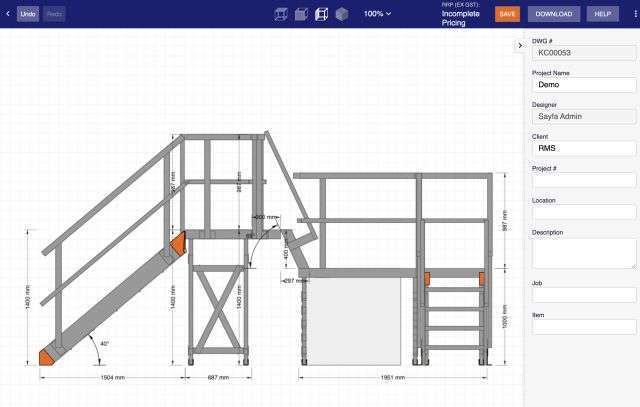If we go back to CAD, its capabilities would be very useful in a situation like this. Think about a powerful yet simple CAD-enabled CPQ, and how useful it would be.
In the manufacturing and design world, computer-aided design (CAD) is a commonly used tool. It is just what its name implies: the use of computers to assist with any aspect and stage of a design. The introduction of CAD allowed for greater quality, productivity, repeatability, and communication for those using it.
But the downside is that CAD can be a very complicated and time-consuming process. CAD software is very powerful, but it can take hundreds of hours of practice to become proficient in its use.
That is why businesses who use CAD generally have trained professionals handling the software, someone who has put in those many hours to understand the process. Not only that, but CAD also usually comes as desktop-only software which limits shareability and collaboration.

That’s all well and good but what if you are trying to allow a degree of customization for end-users who probably wouldn’t know how to use CAD? Is there a way to de-complicate CAD and make its powerful benefits accessible to users who aren’t as well versed in using it? Hold that thought. We’ll come back to it later.
What about CPQ?
CPQ stands for “configure, price, and quote”. CPQ software is very useful when you have a complex product that has a variety of customizable parts. Customers can “configure” their product within the set parameters, see a “price”, and then submit their configuration to the business for a “quote”.

Instead of having to create a product dedicated to each variation, a company can employ CPQ software to cover the overall product, with the variations housed inside.
CPQ is a powerful workflow but it does have some shortcomings, especially in certain fields. When a business includes elements of layout design, it needs more than just the ability to configure or swap out different parts. It needs the ability to actually design a layout free-form and still receive a price, submit a quote, etc. How would that be done?
Simple CAD enabled CPQ
Enter DPQ, or design, price, and quote. DPQ is a concept our company, RoleModel Software, uses to describe the applications we’ve built with our LightningCAD framework, which takes the power of CAD software and bundles it with the easy customization and useability options of a CPQ system.
The complicated CAD work is done behind the scenes, and the user is able to design with simple drag and drop controls, all hosted in a browser with instant access to estimations, parts lists, and more.
LightningCAD and DPQ concepts are the foundation for a number of projects that RoleModel Software has been working on over the last several years.
Real CAD Examples

For example, in 2018 Sayfa contacted RoleModel Software looking for a software solution to design their fall safety platforms. They were growing as a company, but their sales team was handicapped since they needed the support of a draftsperson to update proposals. In some cases, they even had to use hand-drawn markups to keep the process moving. After a short time, it became clear that a LightningCAD DPQ solution would be the best option for Sayfa. The ability to design in 2D, view in 3D, output parts lists and quotes, and integrate with internal systems already in place was just what Sayfa needed.

The Result?
The drafting team was freed up to focus on new innovations, and the sales team could now update quotes and edit proposals on their own. Estimation times were reduced from 4+ hours to about 30 minutes!
According to the project manager:
“Our quoting consistency has vastly improved and the guys are absolutely over the moon about it. Using the configurator to ‘bypass’ the drafting team and go directly to manufacturing has reduced production lead times by 3–4 days. The ROI on our current use of the software internally is massive–at least 80%.”

The Purpose of the Software
Our founder, Ken Auer summarizes the purpose of this software well:
“Since the early 2000s, RoleModel has received requests from companies frustrated with the limitations of the tools their sales people had for engineered-to-order products. Usually, they would say they wanted a tool for their sales team that could “sketch out” what was needed while the software takes measurements and builds the design. The desired tool would need design constraints consistent with their engineering rules so that designs would be detailed and accurate while the sales team couldn’t design products the wrong way. And of course, they wanted the tool to be mobile like their salespeople. Typically, their desire for the tool and their available budget were not a match.
Hurdles to deliver interactive graphical applications
Through experience gained over many years of custom software development, it was clear in the early concept phase that the technical hurdles to deliver interactive graphical applications with domain constraints was too ambitious on a small budget. By 2013, however, technology had advanced to the point where delivery of such an application via a web browser was feasible, which we had discovered as the result of a graphical manipulation research project we explored.
Our theory was that once we had a simplified design framework that could build a simulated model of a product, it wouldn’t be long before we could incorporate other capabilities like 3D modeling, bill of materials, estimates, installation plans, and more. This would make it possible to build custom systems for engineer-to-order business, much cheaper and much more quickly. Finally, everybody who had asked over the years could get what they needed, and we were just getting started.
Framework tested by a non-trivial, real world example
The next hurdle was building a framework tested by a non-trivial, real world example. We found a partner in Decks.com to build a deck designer on top of the framework we built. After that we built a landscape plan take-off tool; then a fall safety platform design tool, a compressed air system design-price-quote tool, and then a dental surgical guided design tool. With each system we built we refined the base framework and integrated with different systems (CRMs, eCommerce platforms, file conversion tools, ERPs, 3D Printers), continually expanding our capabilities.
We’re always improving, but our theory has proven to be true. Custom “design-price-quote” solutions on top of LightningCAD are now accessible for small-to-medium businesses at low-risk and with a quick return on their investment.”
-Ken Auer, Founder and CPO

Collaboration leads to success
To conclude, Design Price Quote technology with LightningCAD is the best of both CPQ and CAD solutions. Through collaboration, our business focused team works with configure/design/construction companies to automate their business rules into a dynamic user-guided design tool. Not only are the capabilities made possible by LightningCAD, but the framework also gives a jump start for customization, so the cost is accessible for most companies.
Currently, LightningCAD has created custom SaaS applications for railing design, dock design, house blueprint design, with many more on the horizon. Custom SaaS with DPQ solutions means that the design tool foundation has been created, then we help individual companies translate their specific building rules into their branded design solution at a low cost.
Explore what it takes to get started today by going to LightningCAD.com!
We want to partner with you to innovate and drive your value.
-Written by: Theo Luciano, Ken Auer, and Jamey Meeker
